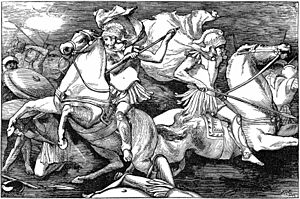Battle of Lake Regillus facts for kids
Quick facts for kids Battle of Lake Regillus |
|||||||
|---|---|---|---|---|---|---|---|
| Part of the Roman-Latin wars | |||||||
|
Castor and Pollux fighting at the Battle of Lake Regillus, 1880 illustration by John Reinhard Weguelin to the Lays of Ancient Rome by Thomas Macaulay |
|||||||
|
|||||||
| Belligerents | |||||||
| Roman Republic | Latin League | ||||||
| Commanders and leaders | |||||||
| Aulus Postumius Albus Titus Aebutius Helva (master of the horse) |
Octavius Mamilius † Tarquinius Superbus |
||||||
| Strength | |||||||
|
Total: 24,700
|
Total: 43,000
|
||||||
The Battle of Lake Regillus was a famous victory for the Roman Republic. It happened soon after Rome became a republic, during a bigger conflict called the Latin War.
The Latin army was led by Lucius Tarquinius Superbus, the last king of Rome, who had been forced out of power. His son-in-law, Octavius Mamilius, who was a leader from Tusculum, also helped lead the Latins. This battle was the last time the Tarquin family tried to get their throne back. A popular story says that the twin gods Castor and Pollux fought alongside the Romans.
Why the Battle Happened
After Rome became a republic, its former friends in Latium became a threat. To protect Rome from invasion, a special leader called a dictator was chosen. This leader was Aulus Postumius Albus.
The exact year of the battle is not fully clear, even to historians long ago. Some sources say it was in 499 BC, while others suggest 496 BC. Modern historians have also suggested other years, like 493 BC or 489 BC.
Lake Regillus was located in a volcanic crater between Rome and Tusculum. The lake was later drained in the 300s BC.
According to the ancient writer Livy, a nearby tribe called the Volsci were sending soldiers to help the Latins. However, the Roman dictator acted quickly, and the Volscian forces did not arrive in time for the battle.
The Battle Unfolds
Dictator Postumius led the Roman foot soldiers. Titus Aebutius Elva was the Magister Equitum, which means "Master of the Horse," leading the Roman cavalry. Tarquin, the former king, was there with his oldest son, Titus. It was said that seeing the Tarquins made the Romans fight with incredible passion.
Early in the fight, King Tarquin was hurt while attacking Postumius. The Master of the Horse, Aebutius, charged at Mamilius, and both were wounded. Aebutius was hit in the arm, and Mamilius was hit in the chest. Aebutius had to leave the main fighting but still directed his troops from a distance.
The former king's soldiers, many of whom were Romans who had been exiled, started to push back the Roman republican forces. The Romans faced a setback when Marcus Valerius Volusus was killed by a spear while attacking Titus Tarquinius. But Postumius brought in fresh soldiers from his own guards, stopping the exiles' advance.
Meanwhile, Titus Herminius Aquilinus, a famous Roman hero, fought Mamilius and killed him. However, as Herminius tried to take Mamilius's armor, he was killed by a javelin. With the battle's outcome uncertain, Postumius ordered the Roman cavalry to get off their horses and fight on foot. This surprise move forced the Latins to retreat, and the Romans captured the Latin camp.
Tarquin and the Latin army left the battlefield, giving Rome a clear victory. Postumius returned to Rome with his army and celebrated a triumph, which was a grand parade to honor a military victory.
Legend and Legacy
A popular legend says that the Dioscuri, Castor and Pollux, fought alongside the Romans. They appeared as two young horsemen. After the battle, Postumius ordered a temple to be built in their honor in the Roman Forum. This temple was built where the gods were said to have watered their horses.
The ancient writer Plutarch also wrote that this battle was the first military experience for a young man named Coriolanus. For his bravery, he received an oak garland, a special honor.
In the 1800s, the Battle of Lake Regillus was celebrated in a famous poem by Thomas Macaulay called Lays of Ancient Rome.
Images for kids




